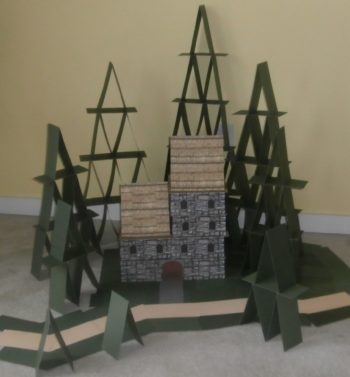
Although the Kardtects House Building system can help you build a range of historic structures, it is always fun reviewing the wondrous facts of buildings themselves, and those of the rooms that we so often take for granted.
Here are 10 interesting and fun facts about one of the most important rooms of a house, beloved by many – the Kitchen and the artifacts we often find in them!
Did you know…?
1)The largest kitchen in the world is in Amritsar, India, at the Sikh Golden Temple, which serves around 100,000 meals every single day of the year and never closes. It is what is called as ‘Langar’, or community kitchen, and literally serves tons of free food from a sprawling complex of white marble and gold.
2)The oldest evidence of a ‘kitchen’ or cooking space, is believed to be found at Wonderwerk Cave, in the Northern Cape province of South Africa. In this huge deep cave is believed to be the earliest evidence of the human use of fire, along with animal bones being found close to microscopic traces of wood ash.
3)The tin can was patented in 1810 by the British merchant Peter Durand. The first canning factory was opened in Bermondsey, England, in 1813.
4)After several decades of people hitting and smashing tin cans to try and open them, the first Can-opener was invented in 1858.
5)The iconic tall chef’s hat, known as the ‘Toque Blanche’, was traditionally made with a hundred pleats in it, which was meant to represent the number of ways an egg could be cooked. The word ‘Toques’, comes from the Arabic ‘taq’, meaning ‘round’. This style of hat was originally worn by French magistrates, but became adopted by Marie-Antoine Caréme and Auguste Escoffier. These two chefs are recognised as the founders of French haute cuisine and they chose the hat to have them seen as the authority figure – the boss – literally “chef” – in the kitchen.
6)The word cutlery comes from the Old French word ‘coutelier’, itself is derived from the word ‘coutel’ – meaning knife. The first record of this use of the word is in an English tax return dating from 1297.
7)According to the Guinness Book of World Records, the ‘Botin’ Restaurant in Madrid, Spain, is the oldest operating restaurant in the world, with the assertion of it opening its doors in 1725. Although, the ‘Stiftskeller St Peter’, found at the monastery in Salzburg, Austria, claims to have been an inn that served food since 803AD!
The contention could be on which actually opened as a ‘Restaurant’, as one is defined as an ‘Inn’. Yet, other contenders for the title include, the ‘Zum Franziskaner’ dating from 1421, located in Stockholm, Sweden, or the famous ‘La Tour d’Argent’ recorded in the 1500s in Paris, France. There is the ‘Die Letzte Instanz’ founded in 1621 in Berlin, Germany, and the ‘A La Petite Chaise’ also of Paris, France, recorded as 1680. The oldest Restaurant in America is found in Boston, dating from 1826, named the ‘Union Oyster House’.
8)Amongst the oldest examples of an actually surviving ‘prepared’ drink, is an actual bottle of Roman funeral wine found during excavation in Germany. This wine is over 1600 years old and has managed to remain in a liquid state due to the olive oil used to successfully seal bottle. Doubt it is drinkable.
9)Amongst the oldest examples of ‘prepared’ food appears to have been found in Oxfordshire, England, which appears to be overcooked bread made with crushed grains of barley, almost 5500 years old. Doubt it has remained eatable – if it ever was.
10)Cookery Books are hardly new, the oldest version seems to be three clay tablets dating back to 1700BC known as the Yale Culinary Tablets, and are part of Yale’s Babylonian collection. These Mesopotamian tablets display the world’s oldest recipes. Researchers believe these recipes were the equivalent to the haute cuisine of their time offering meals fit for royalty.
Experts have deciphered the cuneiform writing to discover 25 recipes for stew, most of which are meat-based plus a few vegetable varieties. However, the recipes only list the ingredients and offer no description of how to cook the dishes. The tablets also list a selection of breads, from plain savory to elaborate sweet cakes, are also mentioned in the tablets. The earliest actual cookery book, with directions and lists of ingredients is the ‘De re coquinaria’ (The Art of Cooking) which dates from the 4th to 5th century.
What kind of kitchen do you imagine inside this castle being built?
